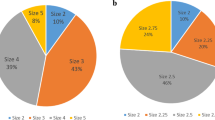Abstract
Introduction and hypothesis
Our aim was to investigate the efficacy of the EndoFast Reliant™ system, which is a novel trocarless mesh technology for the treatment of pelvic organ prolapse (POP).
Methods
This was a retrospective cohort study including 31 female patients with POP who underwent vaginal repair. Total follow-up duration was 24 months. All patients were evaluated with a clinical history, POP-Q measures, pelvic ultrasound, body mass index (BMI), questionnaires on symptoms, and quality of life scoring system.
Results
The mean age was 53 ± 9.7 years, and the mean BMI was 28.5 ± 3.9 kg/m2. The BMI of 20 patients was < 30 kg/m2. No intraoperative complications occurred. Prolapse was anatomically resolved in 87.1% of patients at 2-year follow-up. Four patients presented stage 1 non-symptomatic prolapse recurrence. De novo stress urinary incontinence developed in four (12.9%) cases and de novo urgency developed in two (6.4%) cases; all were diagnosed and treated easily with oral medication. One case of mesh exposure was found and treated conservatively. There was no migration of fasteners or mesh. Urinary retention, postoperative groin pain, and dyspareunia were not observed.
Conclusions
The EndoFast Reliant™ system was found successful with high success rates, short learning time and very low complication rates in our study. However, further prospective studies with higher patient numbers and longer follow-up durations are needed to reach definitive conclusions.

Similar content being viewed by others
Abbreviations
- POP:
-
Pelvic organ prolapse
- ASC:
-
Abdominal sacro-colpopexy
- POP-Q:
-
Pelvic Organ Prolapse-Quantification
- BMI:
-
Body mass index
- UDI-6:
-
Urinary Distress Inventory
- IIQ-7:
-
Incontinence Impact Questionnaire
- FSFI:
-
Female Sexual Function Index
- PFDI-20:
-
Pelvic Floor Distress Inventory
- SUI:
-
Stress urinary incontinence
References
Barber MD, Maher C. Apical prolapse. Int Urogynecol J. 2013;24:1815–33.
Nieminen K, Hiltunen R, Takala T, Heiskanen E, Merikari M, Niemi K, et al. Outcomes after anterior vaginal wall repair with mesh: a randomized, controlled trial with a 3-year follow-up. Obstet Gynecol Surv. 2011;66:411–3.
Nguyen JN, Burchette RJ. Outcome after anterior vaginal prolapse repair: a randomized controlled trial. Obstet Gynecol. 2008;111:891–8.
Nygaard IE, McCreery R, Brubaker L, Connolly AM, Cundiff G, Weber AM, et al. Abdominal sacrocolpopexy: a comprehensive review. Obstet Gynecol. 2004;104:805–23.
Bako A, Dhar R. Review of synthetic mesh-related complications in pelvic floor reconstructive surgery. Int Urogynecol J. 2009;20:103–11.
Alcalay M, Cosson M, Livneh M, Lucot JP, Von Theobald P. Trocarless system for mesh attachment in pelvic organ prolapse repair—1-year evaluation. Int Urogynecol J. 2011;22:551–6.
Alcalay M, Livneh M, Marcus Braun N, Siman Tov Y, Hod E. Mesh pullout force: comparative study of different deployment techniques in a sheep model. Int Urogynecol J Pelvic Floor Dysfunct. 2014;25:103–7.
Marcus-Braun N, Von Theobald P. Cystocele repair with single-incision, trocarless mesh system. Int Urogynecol J Pelvic Floor Dysfunct. 2014;25:285–7.
Visco AG, Wei JT, McClure LA, Handa VL, Nygaard IE. Effects of examination technique modifications on pelvic organ prolapse quantification (POP-Q) results. Int Urogynecol J. 2003;14:136–40.
Cam C, Sakalli M, Ay P, Cam M, Karateke A. Validation of the short forms of the incontinence impact questionnaire (IIQ-7) and the urogenital distress inventory (UDI-6) in a Turkish population. Neurourol Urodyn. 2007;26:129–33.
Aygin D, Eti Aslan F. The Turkish adaptation of the female sexual function index. Turkiye Klin J Med Sci. 2005;25:393–9.
Kaplan PB, Sut N, Sut HK. Validation, cultural adaptation and responsiveness of two pelvic-floor-specific quality-of-life questionnaires, PFDI-20 and PFIQ-7, in a Turkish population. Eur J Obstet Gynecol Reprod Biol. 2012;162:229–33.
Caquant F, Collinet P, Debodinance P, Berrocal J, Garbin O, Rosenthal C, et al. Safety of trans vaginal mesh procedure: retrospective study of 684 patients. J Obstet Gynaecol Res. 2008;34:449–56.
Hugele F, Panel L, Farache C, Kashef A, Cornille A, Courtieu C. Two years follow up of 270 patients treated by transvaginal mesh for anterior and/or apical prolapse. Eur J Obstet Gynecol Reprod Biol. 2017;208:16–22.
Su TH, Lau HH, Huang WC, Chen SS, Lin TY, Hsieh CH, et al. Short term impact on female sexual function of pelvic floor reconstruction with the Prolift procedure. J Sex Med. 2009;6:3201–7.
Long CY, Juan YS, Wu MP, Liu CM, Chiang PH, Tsai EM. Changes in female sexual function following anterior with and without posterior vaginal mesh surgery for the treatment of pelvic organ prolapse. J Sex Med. 2012;9:2167–74.
Ek M, Tegerstedt G, Falconer C, Kjaeldgaard A, Rezapour M, Rudnicki M, et al. Urodynamic assessment of anterior vaginal wall surgery: a randomized comparison between colporraphy and transvaginal mesh. Neurourol Urodyn. 2010;29:527–31.
Author information
Authors and Affiliations
Corresponding author
Ethics declarations
Conflicts of interest
None.
Ethical approval
All procedures performed in this study involving human participants were in accordance with the ethical standards of the institutional research committee and with the 1964 Helsinki Declaration and its later amendments or comparable ethical standards. For this type of study, formal consent is not required.
Additional information
Publisher’s note
Springer Nature remains neutral with regard to jurisdictional claims in published maps and institutional affiliations.
Rights and permissions
About this article
Cite this article
Yildiz, G., Kilic, O., Batur, A.F. et al. Pelvic organ prolapse repair with a trocarless mesh system: two-year results. Int Urogynecol J 31, 1641–1646 (2020). https://doi.org/10.1007/s00192-019-04072-y
Received:
Accepted:
Published:
Issue Date:
DOI: https://doi.org/10.1007/s00192-019-04072-y




